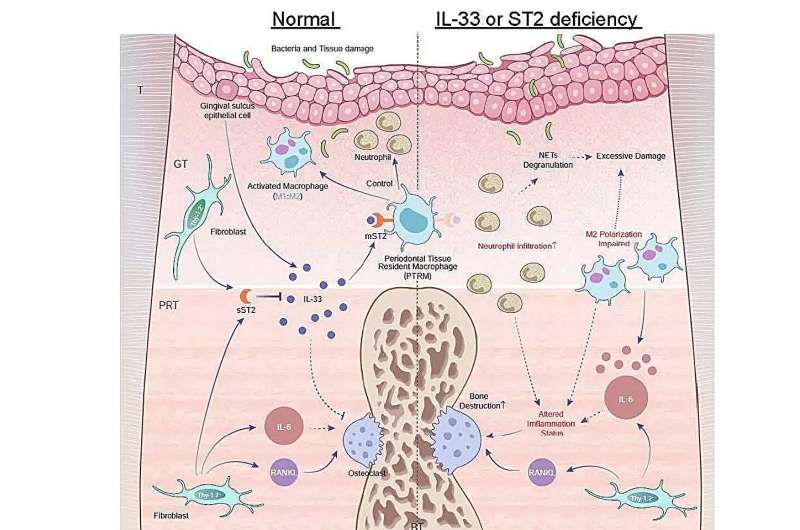Tokyo Medical and Dental College (TMDU) researchers have developed a method that permits an in depth evaluation of periodontitis growth over time.
Periodontal illness, represented by periodontitis, is the main explanation for tooth loss and impacts shut to at least one in 5 adults worldwide. Usually, this situation happens on account of an inflammatory response to bacterial an infection of the tissue round enamel.
Because the situation worsens, the gums start to drag away, exposing enamel roots and bone. Notably, the incidence of periodontitis turns into extra prevalent with age and with populations worldwide dwelling longer, creating a strong understanding of its underlying causes and development is vital.
In a research printed in Nature Communications on March 28 2024, researchers from TMDU discovered a solution to obtain this by bettering upon a broadly used animal mannequin to review periodontitis.
Learning periodontitis immediately in people is difficult. Because of this, scientists usually resort to animal fashions for preclinical analysis. As an example, the “mouse ligature-induced periodontitis mannequin,” since its inception in 2012, has enabled researchers to review the mobile mechanisms underlying this situation.
Merely put, with this mannequin, periodontal illness is artificially induced by ligating silk threads onto the molars of mice fashions, which induces plaque accumulation. Whereas handy and efficient, this mannequin, nonetheless, fails to seize the whole image of periodontitis.
“Although the periodontal tissue consists of gingiva, periodontal ligament, alveolar bone, and cementum, analyses are normally carried out completely on gingival samples attributable to technical and quantitative limitations,” remarks lead writer Mr. Anhao Liu. “This sampling technique limits the conclusions which may be drawn from these research, so strategies that permit for the simultaneous evaluation of all tissue parts are wanted.”
To handle this limitation, the analysis group developed a modified ligature-induced periodontitis mannequin. As a substitute of the traditional single ligature, they used a triple ligature method on the higher left molar of male mice. This technique expanded the vary of bone loss with out inflicting extreme bone destruction across the second molar, growing the yield of the various kinds of periodontal tissue.

“We remoted the three primary tissue sorts and evaluated the RNA yield between the 2 fashions. The outcomes confirmed that the triple-ligature mannequin successfully elevated the yield, attaining 4 occasions the yield of regular peri-root tissue and supporting the high-resolution evaluation of various tissue sorts,” explains senior writer Dr. Mikihito Hayashi.
After confirming the efficacy of their modified mannequin, the researchers proceeded to analyze the results of periodontitis on gene expression among the many completely different tissue sorts over time, specializing in genes associated to irritation and osteoclast differentiation.
One among their primary findings was that the expression of the Il1rl1 gene was markedly greater in peri-root tissue 5 days after ligation. This gene encodes the protein ST2 in each receptor and decoy isoform, which binds to a cytokine referred to as IL-33 that’s concerned in inflammatory and immunoregulation processes.
To realize additional insights into the position of this gene, the group induced periodontitis in genetically modified mice that lacked the Il1rl1 or Il33 genes. These mice exhibited accelerated inflammatory bone destruction, highlighting the protecting position of the IL-33/ST2 pathway. Additional evaluation of cells containing the ST2 protein in its receptor kind, mST2, revealed that almost all of them have been of macrophage lineage.
“Macrophages are sometimes labeled into two primary sorts, pro-inflammatory and anti inflammatory, based mostly on their activation course of. We discovered that mST2-expressing cells have been distinctive in that they expressed some markers of each sorts of macrophages concurrently,” feedback senior writer Dr. Takanori Iwata. “These cells have been current within the peri-root tissue earlier than irritation was triggered, so we named them ‘periodontal tissue-resident macrophages.'”
Collectively, the findings of this research showcase the facility of this modified animal mannequin to review the complete scope of periodontitis in better element, proper right down to the biomolecular stage.
“We propose the chance {that a} novel IL-33/ST2 molecular pathway regulating irritation and bone destruction in periodontal illness, alongside particular macrophages in peri-root tissue, is deeply concerned in periodontal illness. It will hopefully result in the event of latest remedy methods and prevention strategies,” concludes senior writer Dr. Tomoki Nakashima.
